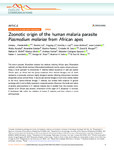2022-04-06Zeitschriftenartikel
Zoonotic origin of the human malaria parasite Plasmodium malariae from African apes
Plenderleith, Lindsey J.
Liu, Weimin
Li, Yingying
Loy, Dorothy E.
Mollison, Ewan
Connell, Jesse
Ayouba, Ahidjo
Esteban, Amandine
Peeters, Martine
Sanz, Crickette M.
Morgan, David B.
Wolfe, Nathan D.
Ulrich, Markus
Sachse, Andreas
Calvignac-Spencer, Sébastien
Leendertz, Fabian H.
Shaw, George M.
Hahn, Beatrice H.
Sharp, Paul M.
The human parasite Plasmodium malariae has relatives infecting African apes (Plasmodium rodhaini) and New World monkeys (Plasmodium brasilianum), but its origins remain unknown. Using a novel approach to characterise P. malariae-related sequences in wild and captive African apes, we found that this group comprises three distinct lineages, one of which represents a previously unknown, highly divergent species infecting chimpanzees, bonobos and gorillas across central Africa. A second ape-derived lineage is much more closely related to the third, human-infective lineage P. malariae, but exhibits little evidence of genetic exchange with it, and so likely represents a separate species. Moreover, the levels and nature of genetic polymorphisms in P. malariae indicate that it resulted from the zoonotic transmission of an African ape parasite, reminiscent of the origin of P. falciparum. In contrast, P. brasilianum falls within the radiation of human P. malariae, and thus reflects a recent anthroponosis.
Dateien zu dieser Publikation

